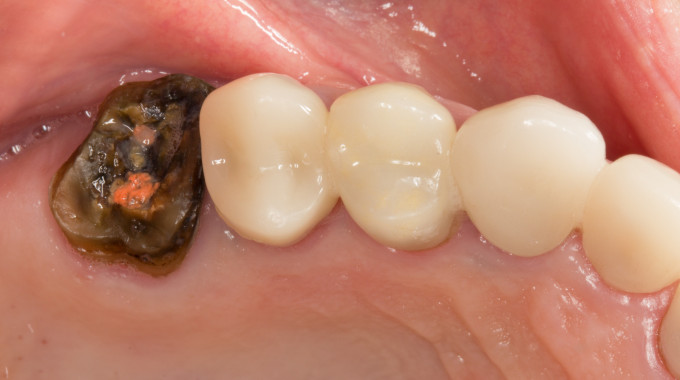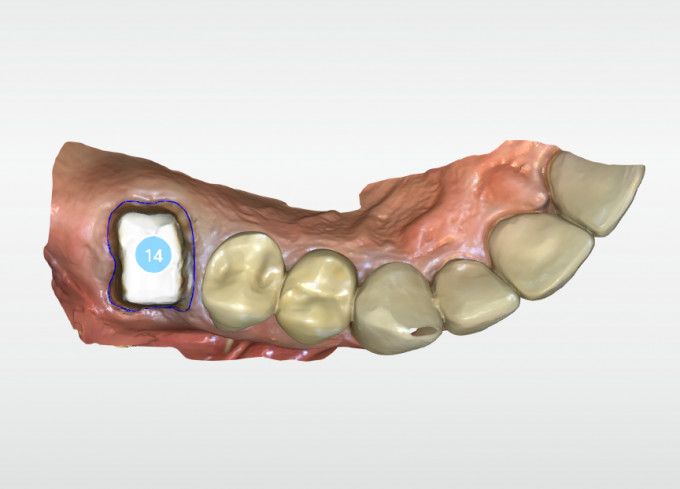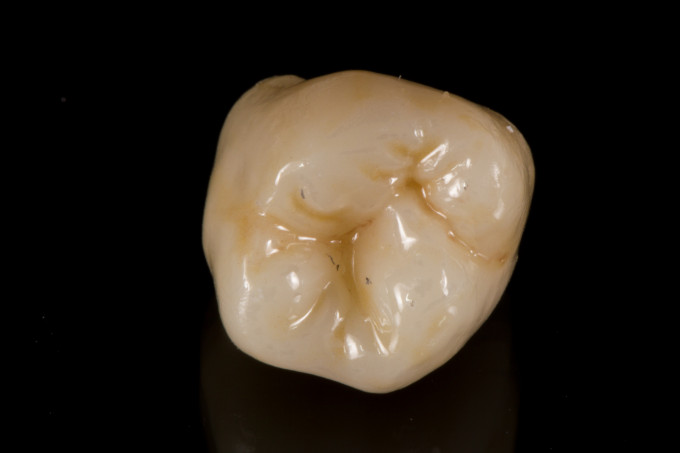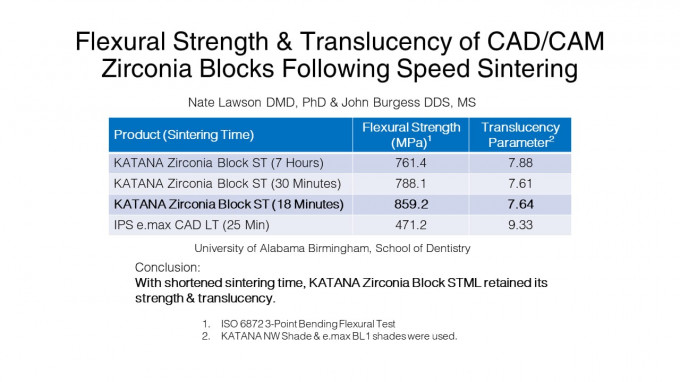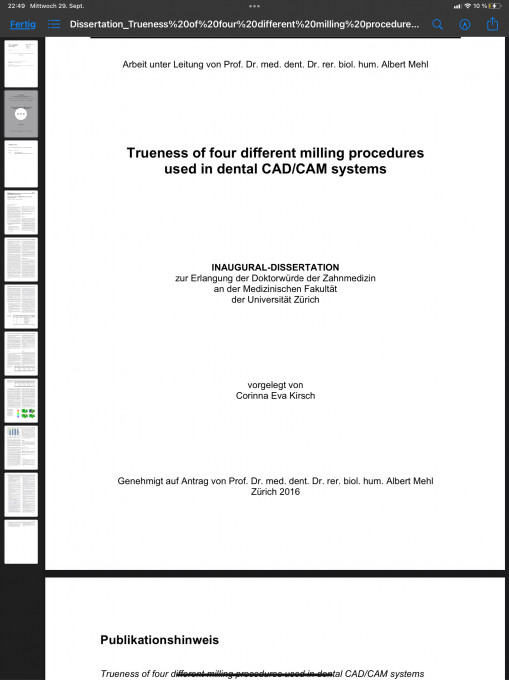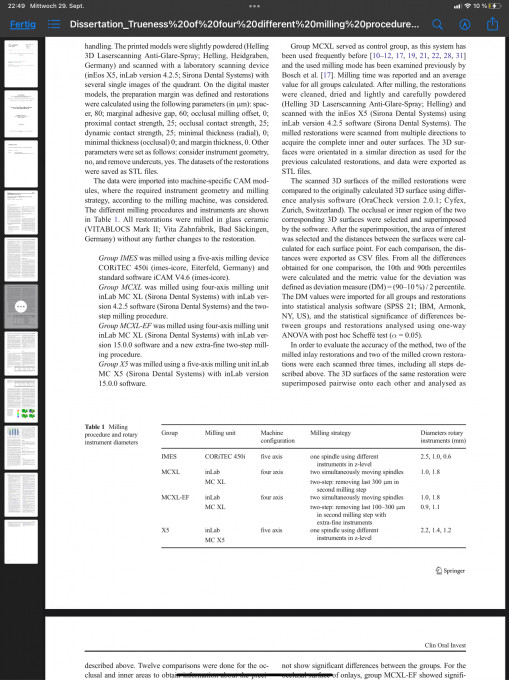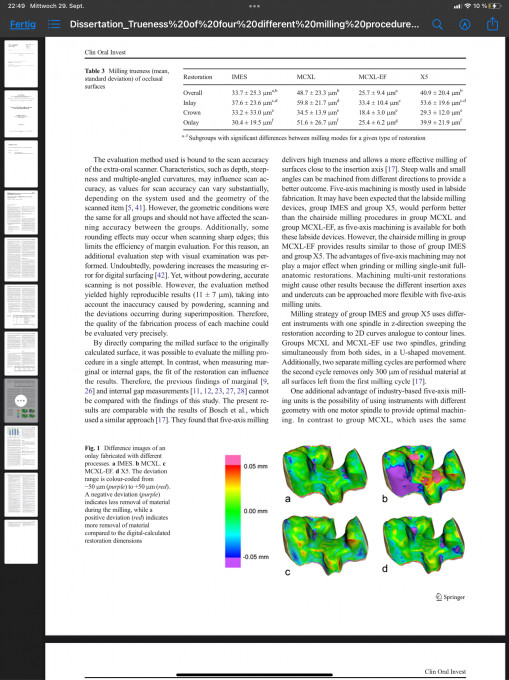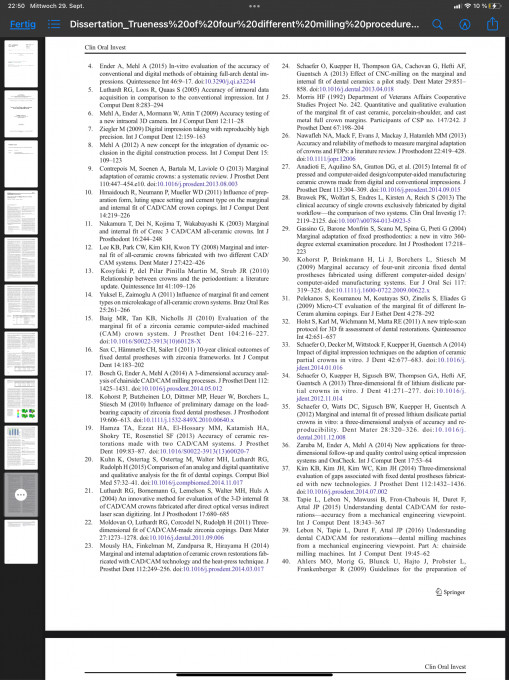Extra Fine Milling Katana STML
Mike Skramstad, DDS
Sponsored by Dentsply Sirona
This patient presented with a RCT tooth that previously had a PFM crown. That crown fractured off and took some of the tooth structure with it.
There was no decay present, excellent oral hygiene, and sufficient tooth structure to make a new buildup and crown for this patient
Since there was no enamel present, the tooth was already prepared for a conventional crown, and we needed to maximize resistance and retention form, a full coverage zirconia crown was chosen. Katana STML was the zirconia we planned to use because the rest of her arch was restored with IPS e.max CAD and we wanted to match the translucency as close as possible.
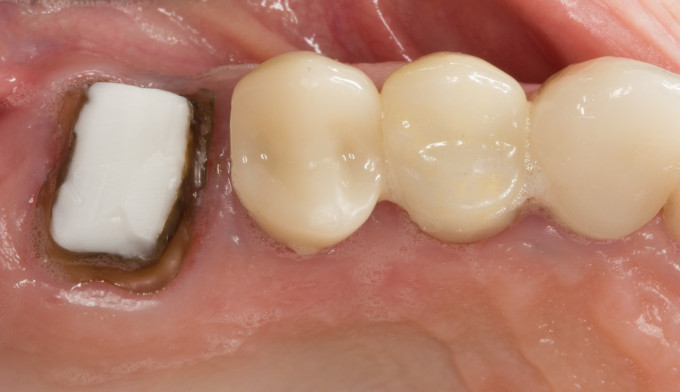
Preparation tooth #14
Since we had some extra time allocated for this patient (1 hour and 40 minutes), we also decided to use the Extra Fine Zirconia milling for this case. In addition to the 2.5 CS shaper bur and 1.0 CS finisher, there is a smaller .5mm CS finisher to create extra detailed anatomy and minimize finishing after the manufacturer process.
After anesthetizing the patient with 4% Articaine, the shade was taken for the restoration. It was determined that we would use an A2 Katana STML block. Once the shade was taken, the block information was entered into the Primemill and the touch process was initiated.
After starting the touch process, the patient information and Administration Phase was completed (designating Katana STML Milling for the restoration).
After a bonded buildup was completed, a full coverage restoration was then prepared with appropriate resistance and retention form for a cementable zirconia restoration. We prepped to the gumline with a 1.0mm modified shoulder (Winter Shoulder) and reduced occlusally by 2.0 mm to guarantee the final restoration had nice anatomy and at least 1.0mm thickness. No retraction cord was used in this case.
After prepping the tooth, the lower jaw, upper jaw and buccal bite were recorded with the CEREC Primescan in Acquisition Phase.

Imaging
The models were processed and the automargination was evaluated. The CEREC Software did an excellent job with the margination and only minor modifications were necessary.
The CEREC software gave an excellent initial proposal and only minor adjustments were necessary to the contours, contact or occlusion.
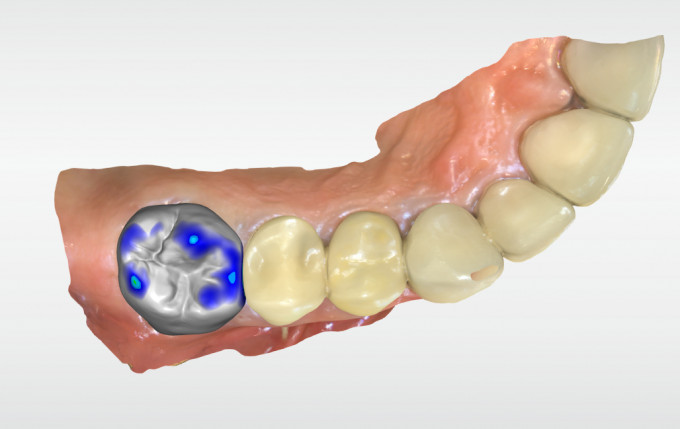
Proposal Design Phase
After evaluating the proposal, the restoration was brought to the Manufacture Phase and sent to the CEREC Primemill. Since the touch process was completed earlier, the milling began immediately.
For this case we used the Extra Fine milling to complete the process. This milling takes substantially longer than the fine or fast milling, but the detail is improved greatly. The total mill time for the Katana STML restoration was 26:59. In most cases, the Extra Fine Milling takes closer to 19 minutes. Since this was such a large restoration, it took longer.
After Extra Fine milling was completed, the restoration was removed from the sprue.
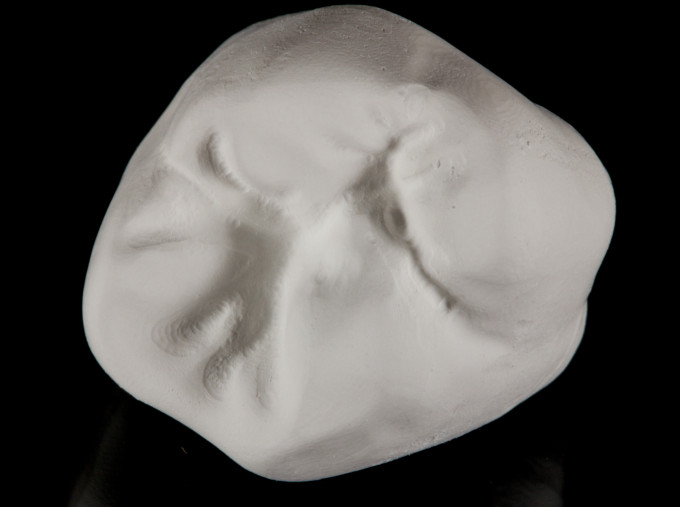
Extra Fine Katana Mill out of mill
Since the anatomy was excellent with the Extra Fine Milling, no extra detail was required and just a minor prepolish completed in the presintered state.

Pre-polish Katana before Sinter
The EF milling definitely reduced the amount of time necessary on the presinter work. The restoration was automatically transferred to the CEREC SpeedFire furnace and sintering was completed in 18 minutes.
After Sintering, the functional surfaces were polished using Brasseler Dialite wheels and then stained and glazed in the CEREC SpeedFire furnace.
After glazing and cleaning the restoration, the CEREC Zirconia was cemented conventionally using resin modified glass ionomer.
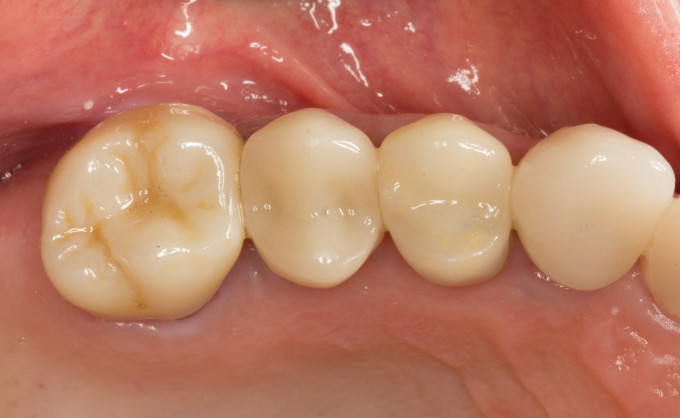
Final Restoration Extra Fine Katana STML #14
The total treatment time for this restoration can be broken down in the following way:
- Anesthesia, entering the block information in the Primemill, Pre-Touch process, and entering the patient and case information: 6 minutes
- Preparing the tooth and tissue management: 9 minutes
- Imaging and designing of restoration: 4 minutes
- Milling of the restoration: 26:59
- Removing restoration from sprue, defining anatomy and prepolish: 2 minutes
- Sintering of the restoration: 18:39
- Cooling of the restoration: 2 minutes
- Post sinter polishing of the restoration and stain/glazing: 5 minutes
- Glazing of the restoration: 9 minutes
10. Cooling of the restoration: 2 minutes
11. Cleaning and final cementation of the restoration: 5 minutes
TOTAL treatment time: 1 hour 30 minutes
The final restoration fit excellent and needed no post cementation adjustments whatsoever. The Extra Fine milling certainly extended the time compared to the Super Fast milling, but even with the extra milling time, the total appointment time fell into an acceptable range. The great thing about the Extra Fine Milling is that we have an option to create additional detail if so required for the case.
The CEREC Primemill not only brings speed to the appointment, but also versatility in milling strategies. In this case we chose extra manufacturing time in order to create a restoration with beautiful detail. This especially is useful when doing bridges as it created beautiful embrasures not possible with fine or fast milling.
When required the CEREC Primemill Extra Fast milling can create anatomy not seen before with conventional manufacturing with the MC XL. While this would not represent my daily workflow, the appointment time is still in a very acceptable range to produce an exceptional result. Options are the key.
Why did you not use e.max that requires the same minimum thickness if the other restorations were also e.max? The bonding of e.max to the tooth is stronger. Is that nit a viewpoint when you have reduced retention form?
EF milling e.max and staining and glazing with speed crystallizsation would have produced also an esthetically good result in a time that is ok.
It is a matter of taste as i have been told by a university professor, but I am a fan of fibre posts in these cases.
By the way: I miss the time you needed for the build-up.
On 9/29/2021 at 9:02 am, Mike Skramstad said...Mike Skramstad, DDS
Sponsored by Dentsply SironaSince there was no enamel present, the tooth was already prepared for a conventional crown, and we needed to maximize resistance and retention form, a full coverage zirconia crown was chosen. Katana STML was the zirconia we planned to use because the rest of her arch was restored with IPS e.max CAD and we wanted to match the translucency as close as possible.
Maybe this is why e.max was not chosen?
From now on my stock answer when people ask why zirconia will be because it’s a posterior tooth ;)
I use zirconia on almost every molar (over 90%) and many premolars. The only exception would be if the prep is no aggressive for what is needed.
emax is amazing and i use it daily for most cosmetic needs, but a bonded emax is still not as strong as zirconia, it doesn’t fit as well, and I love to cement.
Ok, these answer are a little "surprising" for me.
Doing a bonded build-up and prep within 9 min is very respectable. I would need at least 20-25 min for that.
Ok, "because it is a posterior tooth". In the last 4 years (my Cerec career) I have not had one broken e.max restoration on a posterior tooth.
Both e.max and Katana have the same prep requirements so it is hard to see for me why a Katana prep could be less aggressive.
I have not seen until today any scientific research that proofs that bonded e.max is weaker than cemented Katana or even bonded Katana. The bonding adds a significant amount of stability to the system tooth-glue-restoration (therefore bonded e.max has other minimum thickness requirements than cemented) and the bonding of e.max is a lot stronger than the bonding of Katana, even if you use Panavia V5.
Try to remove an e.max crown bonded with Panavia V5 and compare it with a Zirconia crown bonded with Panavia V5 and you will find a significant difference.
Excuse me, but in the absence of any clinical study about the strengths of the complete systems teeth-glue-restorations of the different different materials I take such statements only as being politcal or just as opinions.
I would revise that with scientifical data given that show a significant advantage for Katana.
It’s not that a katana prep is less aggressive but that at the same thickness requirement it has a higher strength (mPa) not to mention you can cement instead of bond :)
On 9/29/2021 at 11:59 am, Michael Saade said... It’s not that a katana prep is less aggressive but that at the same thickness requirement it has a higher strength (mPa) not to mention you can cement instead of bond :)
It does not only depend on the strength of the material.
And I think there is a difference between mPa and MPa.
Armin-
The strength of Katana is simply higher. There is a ton of data on this. You are looking at 550mpa (e.max) vs 750mpa (katana)... some studies have reported Katana higher than that. However I do not think the strength difference is really clinically relevant. They both work excellent.
Here is one respectable study regarding strictly strength:
However, strength has really nothing to do with my decision. I have been using CEREC a very long time (approaching 20 years). I have used e.max with great success since the introduction of the material (and continue to do so). My decision is based on marginal fit and ease of cementation. There is irrefutable evidence that the marginal gap is smaller with zirconia and I can cement them conventionally to make my appointment more stress free and Mike a happier dentist :)
Longevity and success has yet to be determined. Time will tell like always.
Well, I mentioned it two times and will try it one last time:
Nobody doubts that Katana is stronger than e.max.
BUT: the questions is not the stability of the material itself for single restorations but the strength of the material COMBINED with the bonding strength.
Also once again: Please compare the minimum thickness requirements for a cemented e.max crown with the minimum thickness strengths of a bonded minimal prep e.max crown.
So what would you say is the reason for the difference in minimum thickness?
That relativizes the advantage of Katana's strength. e.max's higher bonding strength will make up for this to a certain degree.
And also again: As far as I know there is no real reliable scientific data available.
I also find a change in paradigmas:
I often said that we should use ef grinding over fine grinding e.max because of the better fit. And you told me that this is true but proved clinically irrelevant.
But now with the new Primemill and zirconia it suddenly has become a factor. ☺️
Ok, accepted.
Both material work amazing and one should use whatever they are most comfortable with.
EF mill mostly has a benefit of surface and detail. The fit may be a little better, but in my experience it's not relevant clinically.
There is a study of Eva Kirsch that I can give you that shows a significantly better fit of ef ground e.max vs. f ground e.max.
(You Americans with your "amazing"s "incredible"s etc. They work fine. they are man-made and no miracles.
There is also another scientific paper that is more recent, but I cannot remember where I put it.
Yes I have read that study as it's quite old. It was done at University of Zurich by Mehl/Ender group. I agree with the findings, but it's more to do with overall "trueness" and not necessarily fit in general. It does show less chipping at margins in the EF group (I agree with that in some instances), but that is also heavily prep dependant.
One table is about the trueness of the inner surfaces. F is there 50% worse than EF, resulting in a significantly worse fit. I would call that relevant.
Can you point out where it said worse fit? This is not what trueness measures at all. It’s measuring the milled result in relation to a known value.
I'm really enjoying this and realizing how critical capitalization is. Its like Pelosi vs. Trump or maybe Merkel vs. Horst Seehofer. in a battle of wills. LOL
After glazing and cleaning the restoration, the CEREC Zirconia was cemented conventionally using resin modified glass ionomer.
Mike
Katana STML right.
It looks great Mike. Thanks for sharing. I would have done same thing. I’m sure the patient is chewing on it this evening wondering why you didn’t use emax. Lol.
On 9/29/2021 at 3:09 pm, Mike Skramstad said... Can you point out where it said worse fit? This is not what trueness measures at all. It’s measuring the milled result in relation to a known value.
(A higher trueness results here in a higher accuracy:)
To make it clear with the actual difference of the measuring results of the study:
The grinding results of the fine mode of the MCXL showed a difference of 30 μm (in the average) to the results in extra fine mode in relation to the true value measured by the reference scanner. So if the fine ground restoration is 60 μm different in comparison to the true situation and 30 μm different to the extra fine ground restoration there is a 30 μm difference in fit.
The reference scan is defined as true and the different modes can reproduce that with a difference of 30 μm which will be the difference of fit of the restorations as the consequence.
And in the table of the comparisons of trueness you can also see the numbers of deviations of the grinding results thus showing that also the precision of ef grinding is a lot better than of find grinding, therefore the accuracy is altogether a lot higher.
(To make it even more clear with a quotation directly from the study:
"Clinical relevance:
Accurate milling is required for well- fitting restorations and thereby requires fewer manual finishing steps, yields smaller marginal gaps, resistance to secondary caries and longevity of restorations.")
Armin-
I know this study extremely well. In fact I have had extensive conversations in person with the authors on two separate occasions.
I agree that the trueness of EF is incredible and it actually rivals 5 axis. I agree that the margins are likely better on the average prep because of less chipping.
However, trueness in the internal also has to take into effect preparation, spacer, margin thickness, etc… on a perfect standard prep, the differences may be less. On a normal prep (some roughness) then you will find more differences.
This study is not looking at marginal integrity (others have), but overall trueness.
I will agree that if you want the absolute best milled result, EF is always the way to go. The PM has increased the trueness of all glass grinding too and lowered the EF grinding time by over 30% on average.
Well, Mike, there is only one author: Eva Kirsch because it is an "Inauguaraldissertation" which means it must be by one single person. I believe that Mehl knows a lot about it and not few German professors try to earn the merits for the true authors what I really hate about our academic system.
This study has a lot of valuable informations and implications if one reads it slowly and thoroughly, I think.
And sure: if you have an ideal prep, especially one that resembles perfectly the shape of the mills grinding tools, you will have a much better grinding result than for a rough prep that also causes a lot more chipping which is influencing the trueness to a big degree. And this is a phenomenon that cannot be judged in isolation unfortunately.
I am not sure though how many of us can really preally prep that well and with microscopic smoothness to reduce the amount of chipping to an absolute minimum.
I definitey could not do it within 9 min especially if this would imply an additional build-up.
I spoke to Ender and Mehl about the study… both whom were listed on the study. It’s possible they just supervised it. Not sure.
Mike, it is an Inauguraldissertation. It is a paper that a German dentist has to write on his own (but under control of a professor) in order to call himself a doctor. (Not all German dentist are doctors.)
Not one single word in this study will be by the supervising professor. He might have more or less induced it but it would be illegal from him to claim that it originates from him.



